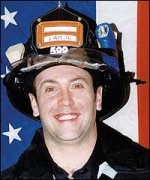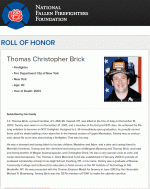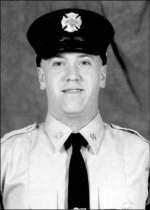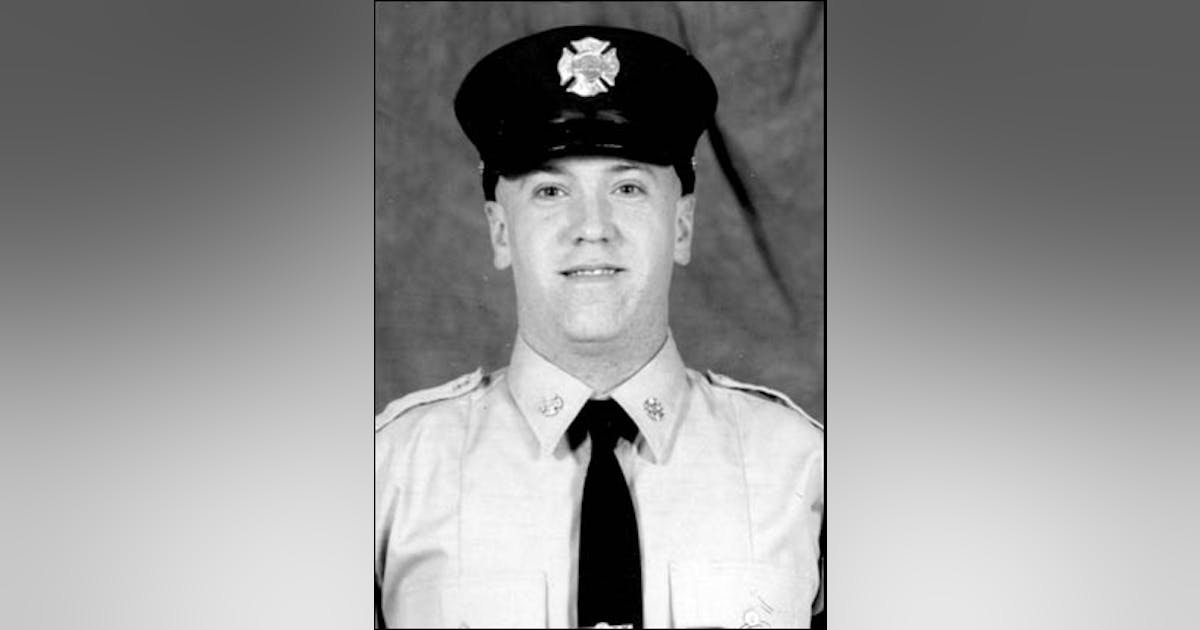
Career Fire Fighter Dies of Carbon Monoxide Poisoning after Becoming Lost While Searching for the Seat of a Fire in Warehouse - New York
 Death in the Line of Duty…A summary of a NIOSH fire fighter fatality investigation
Death in the Line of Duty…A summary of a NIOSH fire fighter fatality investigation
F2004-04 Date Released: March 31, 2005
SUMMARY
On December 16, 2003, a 30-year-old male fire fighter (the victim) died after he became separated from his crew members while searching for the seat of a fire at a furniture warehouse. His crew exited due to worsening conditions and a missing member announcement was made. At one point while inside the warehouse, members of an engine crew thought they heard a scream but could not identify the source. After an evacuation order was given and as engine crew members were exiting, the victim’s officer mistakenly identified one of them as the missing member and cancelled the emergency message. Once fire fighters had exited, a personnel accountability report (PAR) was taken on the street which revealed that the victim was still missing. The victim’s officer initiated a second emergency message for a missing member and a search was begun. The victim, who had a working radio, was found lying face down with his face piece removed and 900 psi left in his self-contained breathing apparatus (SCBA). His Personal Alert Safety System (PASS) alarm was reported by fire fighters to be inaudible. His carboxyhemoglobin (COHb) level was 74.8% in the emergency room.
NIOSH investigators concluded that to minimize the risk of similar occurrences, fire departments should
- ensure that pre-incident planning is performed on commercial structures
- ensure that Incident Commanders (ICs) conduct a risk-versus-gain analysis prior to committing fire fighters to an interior operation, and continue to assess risk-versus-gain throughout the operation
- use guidelines/ropes securely attached to permanent objects and/or a bright, narrow-beamed light at all entry portals to a structure to guide fire fighters during emergency egress
- instruct fire fighters on the hazards of exposure to products of combustion such as carbon monoxide (CO) and warn them never to remove their face piece in areas in which such products are likely to exist
- ensure that team continuity is maintained during fire suppression operations
- train fire fighters on proper radio discipline and operation, and on when and how to initiate emergency traffic when in distress
- train fire fighters on actions to take while waiting to be rescued if they become lost or trapped inside a structure
- ensure that accountability is maintained on the fire ground
- establish a system to facilitate the reporting of unsafe conditions or code violations observed by fire fighters during fire suppression activities
In addition, manufacturers, researchers, and standard setting bodies should
- investigate the performance of PASS devices/alarms under extreme conditions such as those encountered in structural fires
Manufacturers and researchers should
- continue to refine existing and develop new technology to track and locate lost fire fighters on the fireground
- continue to develop and refine durable, easy-to-use systems to enhance verbal and radio communication in conjunction with properly worn SCBA
Additionally, fire prevention personnel should
- enforce current building codes to improve the safety of occupants and fire
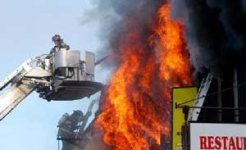 |
Incident scene of four alarm fire |
INTRODUCTION
On December 16, 2003, a 30-year-old male career fire fighter (the victim) died while searching for the seat of a fire in a furniture/mattress warehouse. On December 17, 2003, the U.S. Fire Administration (USFA) notified the National Institute for Occupational Safety and Health (NIOSH) of this fatality. On January 26-29, 2004, three safety and occupational health specialists and a safety engineer from the NIOSH Fire Fighter Fatality Investigation and Prevention Program investigated the incident. A follow-up visit was conducted in April to interview two crews unavailable during the first visit.
The NIOSH team met with representatives of the state fire marshal’s office, the citywide office of occupational safety and health, the Uniformed Firefighters Association and the Uniformed Fire Officers Association (locals of the International Association of Fire Fighters), the chief of safety, and two departmental physicians. The NIOSH team interviewed the officers and fire fighters directly involved in the interior operations and rescue. They reviewed copies of the dispatch run sheet, the death certificate, training records of the victim, and the autopsy report. NIOSH investigators visited and took photographs of the incident site, reviewed a sketch of the warehouse which included the location of contents, standard operating procedures (SOPs), dispatch logs, fire marshal’s report, relevant departmental reports, and the results of SCBA and PASS device post-incident testing.
Department/Training: This career department has approximately 11,500 uniformed fire fighters. It serves a population of about 8 million in an area of approximately 321 square miles. Fire fighters are required to attend a 13-week probationary fire school and to have approximately 100 hours of fire-service-related education each year. The requirements of the initial training school meet or exceed the National Fire Protection Association (NFPA) Fire Fighter Levels I and II certification. The victim had been a fire fighter for just over 2 years. In addition to probationary fire school, the victim had completed other training including live-fire training, HazMat, and search & rescue. He had participated in fighting approximately 100 structure fires during his career.
Structure: The fire occurred on the second floor of a two-story commercial structure with several retail businesses on the first floor and a furniture/mattress warehouse on the second. The building was constructed in 1917 and had been renovated at a later, unspecified date. The building was a Class III brick and joist construction. The roof was flat with 2-in x 12-in wood rafters and a rolled tar surface. The roof had a 40-ft high antenna located near the center and four skylights, each approximately 6-ft x 8-ft. The warehouse had a tin ceiling; there was no cockloft. The wood floor joists were 2-in x 12-in with a hardwood floor covering.
The warehouse was one large room, approximately 53-ft wide by 87-ft deep, with columns down the center (
Diagram 1). It contained mattresses, mattress springs, upholstered sofas and chairs, and other household furniture often stacked to the ceiling. Furniture was stacked on both sides of the center columns and along the walls, some in racks. On Side 1 (northwest wall) mattresses and box springs were stacked on end against the front windows. According to the state fire marshal’s report, the warehouse was at maximum capacity the day of the incident due to a stock delivery several hours before the fire. This reduced the already limited aisle space and produced a maze-like condition (
Diagram 1;
Photo 1). The building had no sprinkler system, smoke detectors, or fire doors. Fire escapes were present and operational. Bars were present on all windows and the rear door was heavily secured with locking devices and steel bars. The front door leading to the second floor had a pull-down gate that was locked when fire fighters arrived.
The building was inspected in June 2000; however, inspectors did not gain access to the second floor. At some unspecified point, the building underwent a change of use without the owner having obtained a new Certificate of Occupancy. Had the owner filed for such a permit it would have initiated an inspection and the requirement to install a sprinkler system to update the occupancy to current building codes. While responding to a fire on the first floor six months earlier, the victim and his crew had searched the second floor and were familiar with its contents. Apparently no information was recorded concerning the contents of the occupancy or that it lacked automatic sprinklers. No Critical Information Dispatch System (CIDS)
a data were available for this occupancy.
Weather and time of day: This incident occurred during the daylight hours with clear weather. Weather was not an issue at this fire.
Self Contained Breathing Apparatus (SCBA) and Personal Alert Safety System (PASS): The victim wore a respirator with a 45-minute carbon fiber air cylinder and an integrated PASS device. The PASS device had two emitters (alarms) located on the sensor module assembly on either side of the air cylinder posteriorly; no emitters were located anteriorly (
Diagram 2). The SCBA, which was less than 2 years old, passed post-incident functional tests done by a private company at the request of the fire department prior to the arrival of the NIOSH team. The same company inspected the PASS device and found that although a continuous tone was emitting, the alarm would not activate. According to the test report, water was present in the battery compartment. Based on a conversation with the chief of safety, the battery cover did not appear damaged or incorrectly fastened.
Radio: Every unit and riding position has a handheld radio (
Photo 2). Most fire fighters have the model shown in the photo which is programmed with one 16-channel zone. The radio model used by chief officers has a liquid crystal display (LCD) and three 16-channel zones. Radios have an emergency alert button on top of the radio that switches the radio to high power (2 watts to 5 watts) and maximum receive volume, and which causes tones to be heard on receiving radios and the transmitting radio on whatever channel is being used. The emergency function also transmits an electronic designator indicating the user’s unit and riding position. The latter information appears on the LCD of receiving radios. Radios are carried in a holster under the bunker gear; remote microphones are clipped to the jacket. The victim had a simple remote microphone with a push-to-talk (PTT) button.
Apparatus and Personnel: Forty-two apparatus and 169 personnel eventually responded to this 4-alarm fire. Apparatus and personnel that were present at the time the victim was reported missing and up to the time he was found are described below. Apparatus
b arrived as follows:
1231 to 1240 hours – initial dispatch: L36 (Officer and 5 members, including the victim); E95 (Officer and 4 members); E43 (Officer and 4 members); E75 (Officer and 5 members); L59 (Officer and 5 members); B13 (Chief [initial Incident Commander {IC}] and 1 member); L46 (Officer and 5 members); D7 (Chief [second and final IC] and 1 member); B19 (Chief and 1 officer); E81 (Officer and 4 members); R3 (6 crew members, the Rapid Intervention Team [RIT]); B19 (Chief and 1 member); E81 (Officer and 4 members); R3 (Officer and 5 members); L33 (Officer and 5 members, designated RIT).
1241 to 1259 hours – second alarm at 1241 hours: E93 (Officer and 5 members); B17 (Chief and 1 member [Communications Coordinator]); B27 (Chief and 1 member [Safety Coordinator]); E72 (Officer and 5 members).
INVESTIGATION
At 1228 hours, an alarm was received for a fire at a commercial structure. The six-member crew of L36 was first on scene at 1231 hours. They reported a working fire with heavy smoke and fire at the rear of the structure. Two members of L36 immediately went to the roof to begin ventilation and one member went to the rear to open the door. Unable to open the rear door, he then went to the roof to assist the ventilation crews. The remaining three members of L36 prepared to enter and search for the fire origin. The B13 Chief who arrived at 1233 hours assumed Incident Command. At 1234 hours, L36 began forcible entry on the roll-down gates to the second floor entrance and E95 began stretching a 2 ½-inch line to the entrance. At approximately 1236 hours, roof cutting operations began. The irons man (forcible entry; the victim) cut the locks on the pull-down door at the bottom of the stairs leading to the second floor. Once the door was opened, the three crew members ascended the stairs and assembled at the top. The upstairs door was open. At this time, visibility was good in the stairs but poor inside the warehouse. At 1239 hours, the D7 Chief arrived and assumed Incident Command from B13. He then sent the B13 Chief to take command of the fire floor. At approximately the same time, the L36 crew donned their face pieces and, with the officer in the lead, crawled into the warehouse. The can man (carries fire extinguisher), a probationary fire fighter, was behind and to the right of the officer, holding onto the officer’s ankle. The victim (irons man) was behind and to the left of the officer. They crawled in about six feet and turned right (because this area was passable) and moved toward the rear. The officer, who was using a thermal imaging camera (TIC), reported that the camera image “whited out” when aimed at the ceiling.
At 1240 hours, E95 entered the warehouse with a charged 2 ½-in hand line. At approximately 1241 hours, the L36 officer heard the victim say something to him in a non-urgent tone which he did not understand. At 1242 hours, E95 brought their hand line up to where the L36 crew was located. At this time, the victim was on the side of the line opposite his crew members – toward the interior. Initially E95 did not open their line because they could not see the fire. At about 1243 hours, however, they were ordered to open their line to cool down the structure and began spraying the ceiling where they could hear fire crackling. At about the same time, E75 brought a back-up 2 ½-inch hand line up to the landing. At 1247 hours, E75 entered the warehouse, positioned its line to the left of E95, and began operating toward the two exposures. At approximately 1249 hours, due to high heat conditions, the L36 officer yelled for his crew to get out. He then turned to the left and moved toward the stairwell. At approximately 1251 hours, when the L36 officer did not see the victim in the stairwell, he sent his can man to the street to look for him and tried radioing the victim and yelling into the structure. At about the same time, E75 withdrew its line to the stairs and the L36 officer began checking exiting members from the fire floor in an effort to locate the victim. At approximately 1253 hours, the officer and nozzle man from E95 thought they heard a scream from inside the fire building. They shut down their line and yelled into the structure for about 30 seconds and, receiving no response, began suppression operations again. At 1255 hours, the IC ordered an evacuation. At 1256 hours, the L36 can man returned to the stairwell and reported that he could not find the victim in the street. The L36 officer verbally informed B13 that he had a missing member. At 1257 hours, B13 transmitted a missing member message to the IC (D7) via an “Urgent” radio transmission. Shortly thereafter, the L36 officer mistakenly identified one of the exiting engine crew members (nozzle man) as his missing member and cancelled the emergency stating that his crew member had been found. At about 1258 hours, the L36 officer yelled into the occupancy and told the two remaining E95 members inside to leave, that he had found his missing member. B13 verified from the L36 officer (face to face) that the missing member had been accounted for and radioed the information to the IC. By approximately1259 hours, all remaining members had left the fire floor and by 1301 hours everyone was off the roof. At about the same time, the IC ordered a defensive operation and L46 began master stream application through the windows. At 1303 hours, after doing a second personnel accountability report (PAR) at street level, the L36 officer realized that his irons man was still missing and probably on the fire floor. He reported this verbally to the B13 Chief and, at 1304 hours, Rescue 3 and the L36 officer returned to the fire floor and began searching for the victim with E75 operating a hand line to protect them. L46 continued to operate into the fire floor. At this time visibility had improved as a result of the vertical and horizontal ventilation. At approximately 1309 hours, the IC ordered L46 to shut down and for all trains to be stopped. Note: Commuter trains, which passed nearby about every two minutes, were causing radio interference.
At 1313 hours, R3 located the victim who was about 30 feet from the stairs near the center columns (
Diagram 1). He was lying beneath a skylight, face down in a pool of water with his head in the direction of the front windows. Two pieces of the tin ceiling were covering him. His face piece was off and the manual shut off switch on the regulator was depressed. The PASS alarm was not audible. When the victim was turned over, the PASS device emitted a faint, monotonous sound. Note: According to the manufacturer (as communicated to the department), this sound indicates a dead-short in the electronics of the PASS. The victim’s radio was on and his left glove was off. The rescue team administered cardio-pulmonary resuscitation (CPR) and then removed the victim from the structure via a rescue basket. He was taken by ambulance to a nearby hospital where he was pronounced dead at 1349 hours. The total time the victim was in the structure from the time he was noted to be missing to when he was found was estimated to be approximately 30 minutes.
Cause of Death
The medical examiner listed the cause of death as smoke inhalation with a carboxyhemoglobin (COHb) level of 74.8% in the emergency department.
RECOMMENDATIONS/DISCUSSIONS
Recommendation #1: Recommendation #1. Fire departments should ensure that pre-incident planning is performed on commercial structures.
Discussion: A pre-incident plan identifies deviations from normal operations and can be complex and formal, or simply a notation about a particular problem, such as the presence of flammable liquids, explosive hazards, maze-like conditions, or structural damage from a previous fire. NFPA 1620 Recommended Practice for Pre-incident Planning
1 outlines the steps involved in developing, maintaining, and using a pre-incident plan and covers factors such as construction, site and occupant considerations, protection systems and water supply, and special hazards (e.g., presence of skylights that are boarded over).
No pre-incident planning had been done for this structure and no CIDS data were available. A fire code inspection was done in this building in 2000; however, inspectors did not gain access to the second floor and, thus, did not know the type of occupancy and whether or not it had automatic sprinklers.
Recommendation #2. Fire departments should ensure that Incident Commanders (ICs) conduct a risk-versus-gain analysis prior to committing fire fighters to an interior operation, and continue to assess risk-versus-gain throughout the operation.
Discussion: Size-up includes a continual evaluation of the risk versus gain during fire operations. Factors to consider for fire suppression operations include characteristics of the structure (e.g., type of construction, age, type of roof system), time considerations (time of day, amount of time fire was burning before and after arrival), contents of the structure, potential hazards such as fuels or explosive materials, life safety hazards, and exposures. The level of risk to fire fighters must be balanced against the potential to save lives or property.
2,
3 This incident occurred in an unoccupied commercial building that required forcible entry. The contents of the warehouse (e.g., overstuffed furniture and mattresses) provided a heavy fire load. Heavy smoke was present upon arrival of fire fighters and zero visibility was present upon entering.
Recommendation #3. Fire departments should use guidelines/ropes securely attached to permanent objects and/or a bright, narrow-beamed light at all entry portals to a structure to guide fire fighters during emergency egress.
Discussion: When a structure is filled with smoke and visibility is poor, especially in large open areas or when there are maze-like conditions, fire fighters can become disoriented or lost, and thus, in need of a guideline to escape.
4-6 For an engine crew, usually this guide is the hose line. For a search crew, it could be a hose from an engine crew or a guide rope. Another strategy is to place a person and/or a bright light at the entry portal as a guide. Illuminated search lines/ropes for fire fighting operations also are available.
7
Recommendation #4. Fire departments should instruct fire fighters on the hazards of exposure to products of combustion such as carbon monoxide (CO) and warn them never to remove their face piece in areas in which such products are likely to exist.
Discussion: The toxicity of CO varies with the length of exposure, the concentration, breathing and heart rate, and the physical condition of the victim.
8,
9 Depending on the concentration, a single unprotected breath of an Immediately Dangerous to Life and Health (IDLH) atmosphere (e.g., products of combustion) may be enough to cause incapacitation.
10 During this incident, before anyone realized the victim was missing, two members of the engine crew thought they heard a scream inside the structure, but they were unable to locate the source of the sound. When the victim was found, his face piece was off. Because of this evidence and his high COHb level, it is postulated that he removed his mask to yell and was quickly overcome by the high concentration of CO.
Recommendation #5. Fire departments should ensure that team continuity is maintained during fire suppression operations.
Discussion: Team continuity relies on knowing your team members and the team leader, maintaining visual contact (if visibility is low, teams must stay within touch or voice distance of each other), communicating needs and observations to the team leader, rotating to rehabilitation, staging as a team, and watching team members (practicing a strong buddy system). In this incident, the victim became separated from his crew in zero visibility.
Recommendation #6. Fire departments should train fire fighters on proper radio discipline and operation, and on when and how to initiate emergency traffic when in distress.
Discussion: The sooner Incident Command (IC) is notified and a Rapid Intervention Team (RIT) is activated, the greater the chances of being rescued. If a partner or an officer is missing and cannot be reached by radio, a Mayday
11 should be called using appropriate terminology, i.e., Mayday for a life-threatening situation such as a missing member or Urgent for a potentially serious problem that is not life-threatening.
12,
13 Emergency traffic receives the highest communication priority from Central Dispatch, Incident Command and other units. All other radio transmissions should stop when this emergency traffic is initiated to clear the channel and allow the message to be heard. Radio discipline includes using standard protocol and terminology; using clear, concise text; talking slowly; and listening. The emergency message must include name and unit, last known location and/or assignment, and type of emergency.
2,
3,
11-15
Fire fighters must receive training in the proper operation of portable radios as well as its limitations and preventive maintenance.
10,
17 At the time of this incident, each fire fighter had a radio which he/she carried in a holster under the jacket and a remote microphone with a push-to-talk (PTT) button. To access the emergency alert button (EAB) on the radio, fire fighters typically have to lift their jackets. The EAB sits in a recessed area on top and toward the front of the radio. This part of the radio is sloped slightly downward for easier access (
Photo 2) but with the small size (¼ inch diameter) and gloves, especially with low visibility, activating the button could be difficult. One approach to improving accessibility is to use microphones which have the emergency alert buttons on the microphone instead of the radio. Note: The department is converting to this system. In addition, communication can be improved with microphones/amplifiers and speaker systems that are integrated into SCBAs. Speakers can be a modified headset that fits in the fire fighter’s ear, under their SCBA face piece.
10,
17
Commuter trains reportedly were causing interference with radio communications and were eventually stopped. Consideration should be given to halting such traffic in close proximity to serious fire department operations early in the operation.
Recommendations # 7. Fire departments should train fire fighters on actions to take while waiting to be rescued if they become lost or trapped inside a structure.
Discussion: Fire fighters must act promptly when they become lost, disoriented, injured, low on air, or trapped.
11-15 First, they must transmit a distress signal while they still have the capability and sufficient air. The next step is to manually activate the PASS device and the emergency button/channel on the radio. To conserve air while waiting to be rescued, fire fighters should try to stay calm and avoid unnecessary physical activity. If not in immediate danger, they should remain in one place to help rescuers locate them. They should survey their surroundings to get their bearings and determine potential escape routes; and stay in radio contact with Incident Command and rescuers. Additionally, fire fighters can attract attention by maximizing the sound of their PASS device (e.g., by pointing it up in an open direction); pointing their flashlight toward the ceiling or moving it around; and using a tool to make tapping noises. A crew member who initiates a Mayday call for another person should quickly try to communicate with the missing member via radio and, if unsuccessful, initiate a Mayday providing relevant information as described above. Note: The victim had a working radio. When found, he had one glove (left) off. It is hypothesized that he removed his glove to activate his EAB. He also had an integrated PASS device; however, the alarm was not heard by fire suppression members or the rescue crew and, according to the report prepared by the testing laboratory, it did not activate.
Recommendation #8. Fire departments should ensure that accountability is maintained on the fire ground.
Discussion: An officer must be able to account for every fire fighter assigned to him or her and to relay this information to Incident Command. Members are responsible for apprising their superior officers of their location and status, and for indicating completion of assignments and duties. Prior to canceling an emergency distress signal for a missing member, the company or unit must identify the individual by conducting a personnel accountability report (PAR) in an organized manner in an uncontaminated area or via radio acknowledgement.
Recommendation #9. Fire departments should establish a system to facilitate the reporting of unsafe conditions or code violations observed by fire fighters during fire suppression activities.
Discussion: The victim’s ladder company had searched the second floor during fire suppression activities on the first floor six months prior to this incident. No evidence existed that the observations of the crew (e.g., lack of automatic sprinklers) were recorded or, if they were, that the information was communicated to fire prevention personnel. This information also did not trigger the creation of CIDS data for this occupancy.
Recommendation #10. Manufacturers, researchers, and standard setting bodies should investigate the performance of PASS devices/alarms under extreme conditions such as those encountered in structural fires.
Discussion: NFPA 1982
19 Standard on Personnel Alert Safety Systems describes the performance criteria and test procedures for PASS devices. Among other requirements, this standard states that PASS devices must withstand 160 degrees F (for 4 hours), a temperature well below that to which fire fighters may be exposed during structure fires.
20,
21 Although it is unclear if high temperatures affected the performance of the PASS device in this incident, NIOSH suggests that researchers, manufacturers, and committee members of NFPA 1982 review the temperature resistance testing requirements for PASS devices to ensure that these temperatures are representative of levels encountered under actual fire conditions.
20,
21
Recommendation #11. Manufacturers and researchers should continue to refine existing and develop new technology to track and locate lost fire fighters on the fireground.
Discussion: Fire fighter fatalities often result when fire fighters become disoriented and lost on the fireground. This is particularly problematic if their PASS alarm is inaudible. NIOSH has investigated similar incidents in which PASS alarms were inaudible for undetermined reasons. In addition to ensuring that the primary PASS device is properly maintained and functioning as designed, it is possible to supplement the regular PASS alarm with a redundant system. One such system sends a warning signal to Incident Command indicating the existence of an emergency and the identity of the member; it also can send an evacuation signal to members.
22 Acoustic devices that emit sounds above the threshold of human hearing (ultrasonic) also have been utilized.
23 Such devices emit sounds that can be detected by tracking devices and have been investigated in fire fighter training scenarios. Yet another possibility to consider is the use of electro-magnetic systems. Extremely Low Frequency (ELF), Very Low Frequency (VLF) and Low Frequency (LF) electro-magnetic systems that emit signals in the 0 to 300 kHz range have been tested and found useful as location devices for locating trapped miners and in ski patrol rescue.
24
Recommendation #12. Manufacturers and researchers should continue to develop and refine durable, easy-to-use systems to enhance verbal and radio communication in conjunction with properly worn SCBA.
Discussion: The use of Personal Protective Equipment (PPE) and an SCBA make it difficult to communicate, with or without a radio.
10,
17 Faced with the difficult task of communicating while wearing an SCBA, fire fighters sometimes momentarily remove their face pieces to transmit a message directly or over a portable radio. Considering the toxic and oxygen-deficient hazards posed by a fire and the resulting products of combustion, removing the SCBA face piece, even briefly, is a dangerous practice that should be prohibited. To facilitate communication, equipment manufacturers have designed face piece-integrated microphones, intercom systems, throat mikes and bone mikes worn in the ear or on the forehead.
10,
17
Emergency alert buttons (EABs) on radios are useful features that are designed primarily for law enforcement, but their design does not work well with the demands of fire fighting, e.g., wearing heavy gloves in low visibility.
10 The EABs of the radio used by this department are ¼ inch in diameter and are located on the radio itself. The radios are carried in a holster under the jacket of the bunker gear meaning that fire fighters must lift their jacket to access the emergency button. Ideally, radios that do not have the EAB located on the microphone should be worn in a place where channel selectors and EABs are readily accessible to the member without interfering with personal protective equipment, e.g., in a radio pocket outside the coat.
10 The department is converting to a system in which the emergency alert button is located on the microphone.
Recommendation #13. Fire prevention personnel should enforce current building codes to improve the safety of occupants and fire fighters.
Discussion: The NFPA Fire Protection Handbook
25 states “throughout history there have been building regulations for preventing fire and restricting its spread. Over the years these regulations have evolved into the codes and standards developed by committees concerned with fire protection. The requirements contained in building codes are generally based upon the known properties of materials, the hazards presented by various occupancies, and the lessons learned from previous experiences, such as fire and natural disasters.” Although municipalities have adopted specific codes and standards for the design and construction of buildings, structures erected prior to the enactment of these building laws may not be compliant. Such new and improved codes can improve the safety of existing structures. Sprinkler systems are one example of a safety feature that can be retrofitted into older structures. Such systems have been shown to reduce loss of life and property.
26 Sprinkler systems can reduce fire fighter fatalities since such systems contain and can extinguish fires prior to the arrival of the fire department. In this incident, code enforcement personnel were unable to inspect the second (fire) floor during a routine inspection of the building because they could not gain access. After the fire, it was determined that the owner had not applied for a permit to change the type of occupancy which automatically would have triggered an inspection and the need for installation of automatic sprinklers.
REFERENCES
- NFPA [2003]. NFPA 1620: Recommended practice for pre-incident planning. Quincy, MA: National Fire Protection Association.
- NFPA [2002]. NFPA 1561: Standard on emergency services incident management system. Quincy, MA: National Fire Protection Association.
- NFPA [2002]. NFPA 1500: Standard on fire department occupational safety and health program. Quincy, MA: National Fire Protection Association.
- Klaene BJ and Sanders RE [2000]. Structural fire fighting. Quincy, MA: National Fire Protection Association.
- Dunn V [1999]. Command and control of fires and emergencies. Saddlebrook, NJ: PennWell Publishing Co.
- Norman J [1998]. Fire officers handbook of tactics. 2nd ed. Saddle Brook, NJ: Fire Engineering Books and Videos.
- Luminexc [2004]. Luminex safety and emergency products. http://www.luminex.comexternal icon. Date accessed: 11/17/04.
- Merck Research Laboratories [1999]. The Merck manual of diagnosis and therapy. 7th ed. Whitehouse Station, NJ: Merck Research Laboratories.
- Ernst A, Zibrak JD [1998]. Carbon monoxide poisoning. NEJM 339(22): 1603- 1608.
- USFA/FEMA [1999]. Improving firefighter communications. USFA-TR-099. Emmitsburg, MD: United Stated Fire Administration.
- Angulo RA, Clark BA, Auch S [2004]. You Called Mayday! Now What? Fire Engineering, September issue.
- Clark BA [2004]. Calling a mayday: The drill. [http://cms.firehouse.com]. Date accessed: November 2004. http://www.firehouse.com/external icon (Link updated 6/13/2006)
- DiBernardo JP [2003]. A missing firefighter: Give the mayday. Firehouse, November issue.
- Sendelbach TE [2004]. Managing the fireground mayday: The critical link to firefighter survival. http://www.firehouse.com/article/10541890/managing-the-fireground-maydayexternal icon. (Link updated 1/8/2013) Date accessed: November 2004.
- Miles J, Tobin J [2004]. Training notebook: Mayday and urgent messages. Fire Engineering, April issue.
- NFAAA [2000]. Firefighter’s handbook: Essentials of firefighting and emergency response. National Fire Academy Alumni Association. New York: Delmar Publishers.
- TriData Corporation [2003]. Current status, knowledge gaps, and research needs pertaining to fire fighter radio communication systems. Report prepared for NIOSH. Arlington, VA: TriData Corporation.
- Nasta M [2003]. Mayday training. Fire Engineering. August issue.
- NFPA [1998]. NFPA 1982: Standard on personal alert safety systems (PASS). Quincy, MA: National Fire Protection Association.
- Madrzykowski D, Forney GP, Walton WD [2002]. Simulation of the dynamics of a fire in a two-story duplex – Iowa, December 22, 1999. Gaithersburg, MD: U.S. Department of Commerce, National Institute of Standards and Technology, U.S. Department of Commerce.
- Madrzykowski D, Walton WD [2004]. Cook County Administration Building fire, 69 West Washington, Chicago, Illinois, October 17, 2003: Heat release rate experiments and FDS simulations. Gaithersburg, MD: U.S. Department of Commerce, National Institute of Standards and Technology, NIST Special Publication SP-1021, pp. 69-72.
- GEM TPASS 3 Evacuate™ Systemd [2005]. Grace Industries – life safety products for public safety, industrial and recreational applications. http://www.graceindustries.comexternal icon. (Link updated 4/2/2009) Date accessed: 2/2/05.
- Nessler NH [2000]. Electromagnetic location system for trapped miners. Subsurface sensing techno. & apps. 1(2). April issue.
- Walter J [2003]. Feature reviews: Avalanche beacons. Gearreview.com. [http://www.gearreview.com/beacons.aspexternal icon]. Date accessed: October 2003.
- NFPA [1997]. Fire protection handbook. 18th ed. Quincy, MA: National Fire Protection Association, p. 1-42.
- NFPA Fire Analysis Division [1987]. Automatic sprinkler systems do have an impact in industry. Fire Journal, January issue.
a CIDS data originate from routine inspection activities and include data that affect fire suppression operations such as building construction, location of standpipes, and building contents.
b L=Ladder; E=Engine; B= Battalion; R=Rescue; D=Division
c Mention of any company or product does not constitute endorsement by the National Institute for Occupational Safety and Health.
d Mention of any company or product does not constitute endorsement by the National Institute for Occupational Safety and Health.
INVESTIGATOR INFORMATION
This investigation was conducted by Linda Frederick, Jay Tarley and Carolyn Guglielmo, Safety and Occupational Health Specialists, and Tim Merinar, Safety Engineer, Fire Fighter Fatality Investigation and Prevention Program, Division of Safety Research, Surveillance and Field Investigations Branch, NIOSH. The report was written by Linda Frederick.
Photographs AND Diagrams
 |
Photo 1. Interior of structure showing contents after fire suppression |
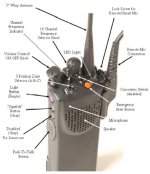 |
Photo 2. Type of hand-held radio used by victim |
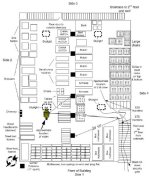 |
Diagram 1. Interior of building |
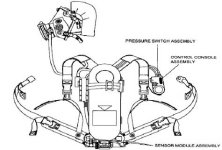 |
Diagram 2. Integrated PASS device |
Career Fire Fighter Dies of Carbon Monoxide Poisoning after Becoming Lost While Searching for the Seat of a Fire in Warehouse - New York

www.cdc.gov

